-
GIGABYTE X58A-OC First Touch and Preliminary Performance Review
Introduction
ASUS have for a long time been producing their ROG series that we all feel is very well targeted to overclockers. Recently Gigabyte got into the game with their release of the high end X58A-UD9 board, but where both of these platforms fall short is being designed from the ground up by overclockers for overclockers, and this is where the X58A-OC steps in.
From the pictures already released you can see this board means business, with an IO panel that looks like it lost a leg in the war to features such as OC-VRM and OC-Touch it's clear this board has potential to be a serious contender.
I don't have the extreme performance I know your all hungry for quite yet but today is just a quick look at performance and a demonstration of the OC Touch feature set. Later I will investigate the extreme performance from this board when paired with an Intel 990X processor.
I have picked a few benchmarks that I like to use when comparing performance on different platforms. Vantage Performance, SuperPI 8m, 3DMark03 and Everest. These four give a good overview of motherboard performance and any areas a board might excel or have problems.
Test Platform
GIGABYTE X58A-OC @ 4GHz, 3276 MHz uncore
Intel 980X Gulftown
GSKILL Perfect Storm 2000 9-9-9-24 @ 910 8-9-8-24
CORSAIR Force SSD 60GB
GIGABYTE HD 5870
All benchmarks are run on the same clean operating system, the same versions of software and drivers and with no addition tweaking done in BIOS.
Preliminary Performance Analysis
Vantage Performance
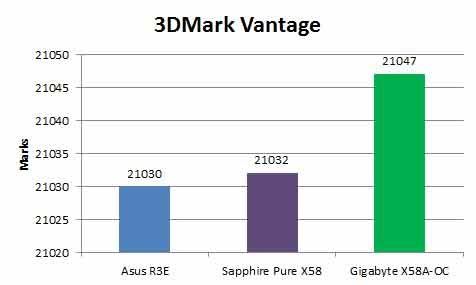
A strong note to start on, despite what looks to be a big lead on the graph, there is not a lot in it, but the OC does take the lead. This is an important result as the X58A-UD9 was a little of the mark when it comes to 3DMark scores, a little behind ASUS. Gigabyte hits back hard here with efficiency that is capable of taking world records
SuperPI 8M
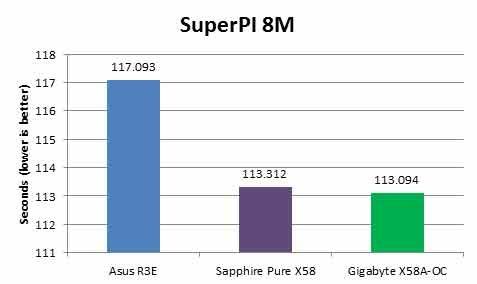
So with the SuperPI 8M graph the lower the seconds taken to complete 8M, the better the result. Again here the results are in favor of the OC, followed closely behind by the Sapphire PURE X58 which I have mentioned is very efficient out of the box in the past.
The X58A-UD9 which I will continue comparing back to throughout this report is an extremely fast board for SuperPI and while the OC is a "TOUCH" behind when I compared them directly it is only by under 100ms over 3 separate runs. I would be confident this board could take out low clock challenges, I guess we will shortly find out!
3DMark03
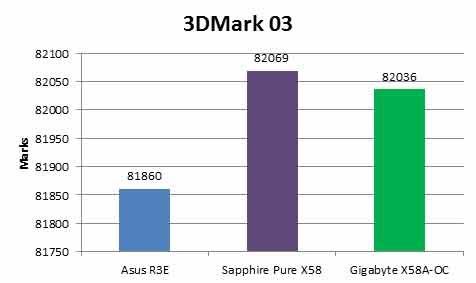
In 3DMark03 the Sapphire board pulls a nice figure that puts it into first place but the OC is only 30 marks behind. Again this is an encouraging result as the UD9 was a few hundred marks behind when it came to single card 3DMark03.
Everest

There is no shame losing to an ASUS board in Everest bandwidth as ASUS bios are always apply tight settings from the out set. This difference of 20 MB/s between all 3 boards shows there is nothing in it with all boards on a level playing field for write bandwidth.
With this result in mind it does explain the 200 milliseconds the Sapphire is behind the Gigabyte in 32m, but doesn't go anywhere to explaining the R3E being 4 seconds off the pace. As can be seen on low clock challenge threads when the R3E is tightened up it is arguably the fastest X58 board on the planet... but for how long?
OC-Touch Demonstration
This feature kicks serious ass, Gigabyte have been slow on the uptake with a hardware style frequency control but I love the multiplier adjustment, this will change the way I bench. No more having to worry about software hotkeys for multiplier adjustments. The keyboard hooks running in the background polling the system every however many milliseconds for keystrokes the better.

Results
Here are the screen shots from the above results plus a few more I ran
Vantage X looks good , a little more efficient than the Sapphire X58, where it should be for a board aiming to be the premier overclocking platform in the world
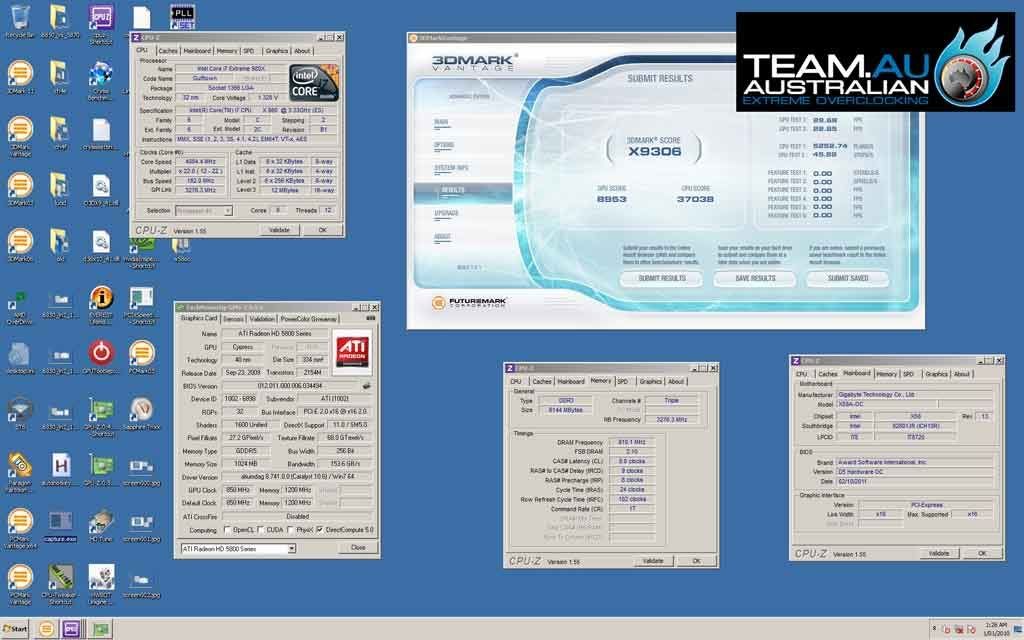

some high clock 32M with the Corsair GTX6 sticks and CPU on air
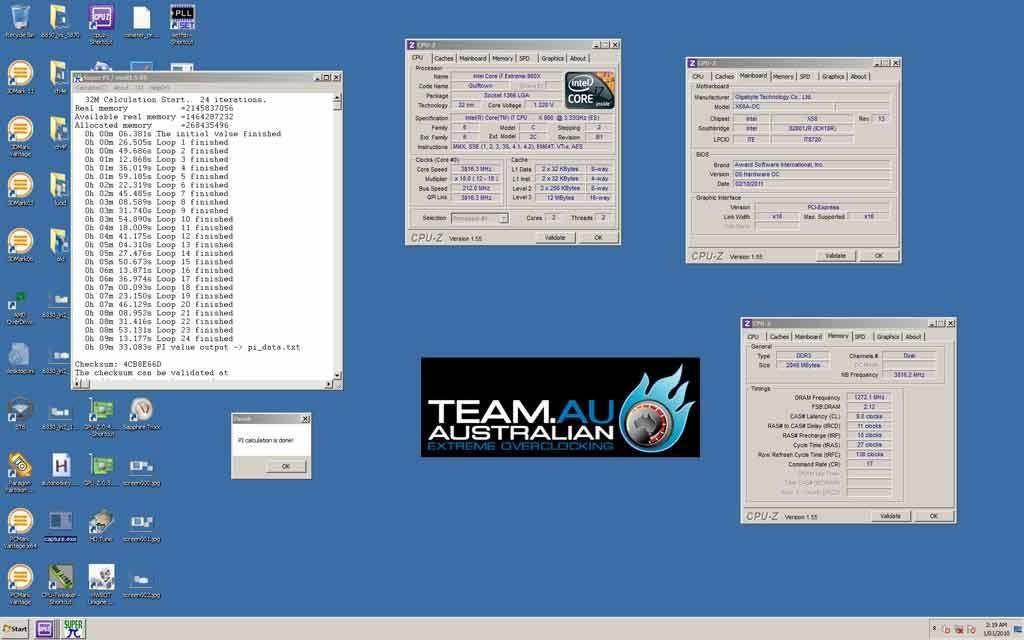
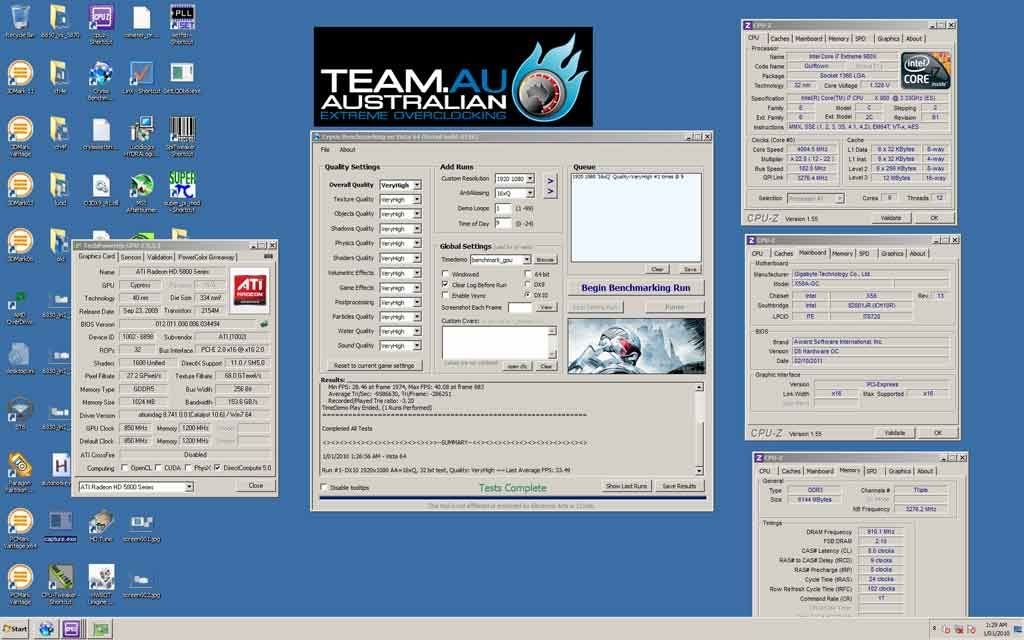
 Posting Permissions
Posting Permissions
- You may not post new threads
- You may not post replies
- You may not post attachments
- You may not edit your posts
-
Forum Rules













 Reply With Quote
Reply With Quote

Bookmarks